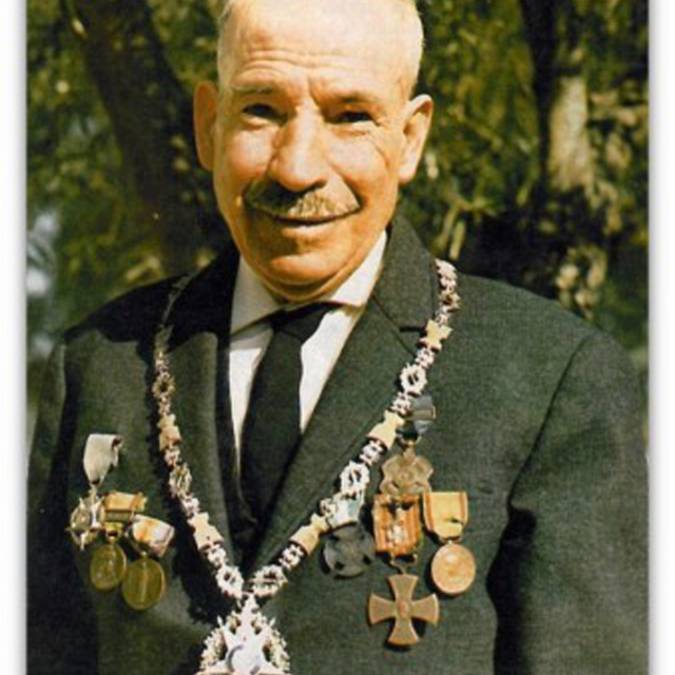"I am decorating you but you deserve the Council of War" Major Fereira do Amaral
Because history is always written by the victors, it is studded with victories, glorious advances and remarkable feats of arms. For the Portuguese Expeditionary Corps (C.E.P), it was in the chaos of defeat and disobedience that this hero was incarnated.
The origin of the story is quite banal. A little man (1.55 m) in his twenties, he embarked, like so many others, for a country he did not know, and for an action about which he had only a vague idea: to fight. It is true that the “Portuguese miracle” was considerable. In a few months, the Tancos Military Training Centre created one, then two divisions, in order to form an army corps.
Anibal Augusto Milhais Gote was born on July 9, 1895 in Valongo, near Porto. A labourer without any education, he was drafted on July 30, 1915 and joined the infantry of the CEP in 1917. He served under Commander Fereira do Amaral as a private. Very quickly, the private soldier proved to be an excellent marksman.
In April 1918, he was in the trenches of the Ferme du Bois sector in La Couture. Following the troops in their movements, he arrived at Huit Maisons (area of La Couture) on the day of the outbreak of the Battle of the Lys. On Easter Monday, the eve of the rotation of the troops, the enemy attacked early in the morning and in the fog, shelling relentlessly, cutting communication relays, and advancing steadily, making sure to generate as few casualties as possible.
Around 10 am, the allies were approaching the sector of Huit Maisons. This redoubt was commanded by the British Major Furse, in charge of the Seaforth Highlanders and King Edward’s Horse Regiments. The Portuguese troops of Lieutenant Fontesy's 15th Battalion were also present. Facing them, the Allied forces stayed put and waited for reinforcements.
Around 12:20 pm, and after four hours of resistance, the survivors of the 2nd Company of the 14th Battalion joined them by the road to Pont du Hem, pursued by the Germans. The assault continued in waves, but Huit Maisons held out.
Around 2 pm, the enemy began to circumvent the position to encircle this fortified position. Major Furnes then gave the order to evacuate. Everyone obeyed except Anibal, who uttered for the first time this phrase that would become famous: "get out, I'll cover you". The young Milhais, in disobeying orders, risked a court martial, but he refused to leave his position. Armed with his Lewis machine gun, he covered the retreat of the troops.
Then he undertook a series of heroic acts worthy of a legend. He first covered the retreat by relentless strafing, to the point of blocking the road for the Germans. His expertise enabled him to fire at a range of about 200 meters. In addition, his small size enabled him to jump from trench to trench and to move about stealthily. To reload the machine gun, he used the cartridge belts of dead soldiers. Such control suggested to the Germans that the sector was held by a battalion. When the assault began, Anibal was already gone; he took advantage of a tent canvas and a dead horse carcass to hide and was overtaken by the attacking troops. In the days that followed, he wandered around, lost, but continued sporadic attacks whenever the opportunity arose. On April 13, he came across a column of Highlanders escorted by Germans and organized their escape by intense strafing. Accompanying the Scots, he returned to Allied lines. It was then that, while crossing a swamp, he saved a Scottish major from drowning. This shy little man became a legend.
Thereafter, Anibal Milhais continued to fight in Ypres and covered the retreat of a column of Belgian and French soldiers.
Having risen to fame in his lifetime, it was impossible to bring such a soldier before a court martial for disobeying orders and performing so many acts of bravery. Private Milhais received, directly on the battlefield and in front of 15,000 soldiers, the Belgian War Cross, the Victoria Cross, and the Collar of the Ordre Torre e Espada. In addition to these decorations, he received the nickname of “Soldier Millions”: “Chamas-te Milhais, mas vales milhoes” , which means, “Your name is Milhais, but you are worth millions”.
After the armistice, having become a living legend, he returned to Portugal on February 2, 1919. There, he married Maria de Jésus and assisted her to raise their 9 children.
To pay tribute to the hero, his native village was renamed Valongo de Milhais on July 8, 1924. But life was not easy in the Portuguese countryside in the 1920s. To cope with the crisis, he emigrated to Brazil in 1928. When the community became aware of his departure, they organised a big collection for the return of their hero. The funds allowed him to live a little more decently. When he returned to Portugal on August 5, 1928, the Portuguese Government gave him an annuity.
The most decorated soldier in the history of the Portuguese army died on June 3, 1970 in the village that bears his name.
Sources:
L’histoire du soldat Milhoes par Anibal Milhais: https://www.bing.com/videos/search?q=o+soldado+milhoes&&view=detail&mid=62647026CC11C4C7EA3E62647026CC11C4C7EA3E&FORM=VRDGAR
Francis CARPENTIER: Loisne et Lawe, le village de La Couture dans la Grande Guerre, Ed La Couture, Champs de Cultures, 2013
Manuel de NASCIMENTO, Première Guerre mondiale (centenaire 1914-2014), Ed L’Harmattan, Paris 2014
Phil TOMASELLI: The Battle of the Lys 1918, Ed Pen & Sword Military, Barnsley 2011
